Company Remains Focused On Worker Health And Safety, Long Term Growth
Springdale, Arkansas – November 16, 2020 – Tyson Foods, Inc. (NYSE: TSN), one of the world’s largest food companies and a recognized leader in protein with leading brands including Tyson, Jimmy Dean, Hillshire Farm, Ball Park, Wright, Aidells, ibp and State Fair, today reported the following results:

1 Adjusted sales, adjusted operating income and adjusted net income per share attributable to Tyson (Adjusted EPS) are non-GAAP financial measures and are explained and reconciled to a comparable GAAP measure at the end of this release. Adjusted sales, adjusted operating income and adjusted EPS for the fourth quarter and twelve months of fiscal 2020 are presented on a 13-week and 52-week basis, respectively.
Fiscal 2020 Highlights
- GAAP EPS of $5.86, up 6% from prior year; Adjusted EPS of $5.64 (52-week basis), up 3% from prior year
- GAAP operating income of $3,114 million, up 10% from prior year; Adjusted operating income of $3,116 million (52-week basis), up 5% from prior year
- Total Company GAAP operating margin of 7.2%; Adjusted operating margin of 7.4% (52-week basis)
- Generated approximately $3.9 billion of operating cash flows
- Results negatively impacted by approximately $540 million of direct incremental expenses related to COVID-19
Fourth Quarter Highlights
- GAAP EPS of $1.90, up 88% from prior year; Adjusted EPS of $1.81 (13-week basis), up 50% from prior year
- GAAP operating income of $1,012 million, up 68% from prior year; Adjusted operating income of $961 million (13-week basis), up 40% from prior year
- Total Company GAAP operating margin of 8.8%; Adjusted operating margin of 9.0% (13-week basis)
- Liquidity of $3.2 billion at October 3, 2020
- Reduced total debt by $690 million
- Results negatively impacted by approximately $200 million of direct incremental expenses related to COVID-19
“Our business performed well and delivered strong fourth quarter and full-year results,” said Dean Banks, President & CEO of Tyson Foods. “Our team members, agricultural partners, and customers have shown resilience. This has enabled us to maintain and accelerate our efforts to provide global consumers with a safe and accessible food supply.”
“While we will continue to face pandemic-related challenges in fiscal 2021, we’re settling the business down to be focused on executing our long-term strategy while generating strong returns for shareholders. I’m excited for the opportunities ahead for this great company, and am certain we have the people, products, and strategies in place to drive future growth.”
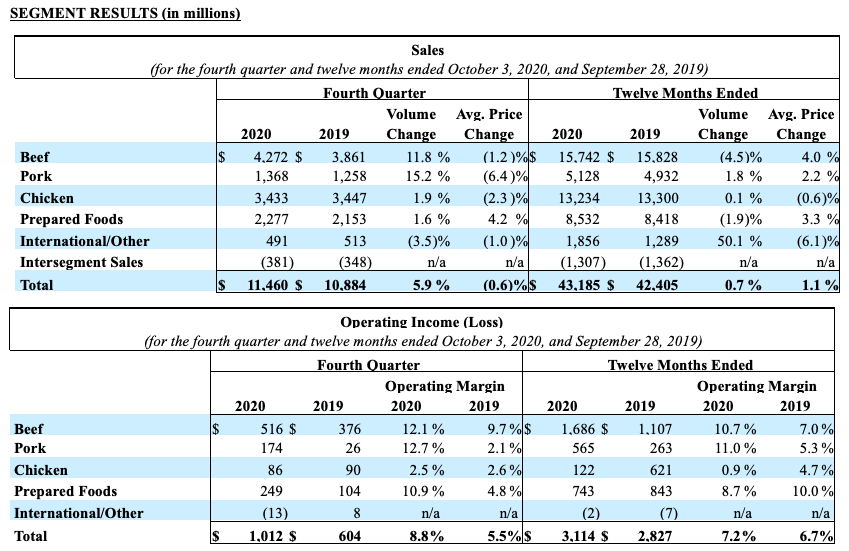
Note: On June 3, 2019, we acquired the Thai and European operations of BRF S.A. The post-acquisition results from operations of these businesses are included in International/Other for segment presentation. On November 30, 2018, we acquired Keystone Foods. The post-acquisition results from operations of this business are included in our Chicken segment for Keystone's domestic operations and results for operations of Keystone's International business are included in International/Other for segment presentation.
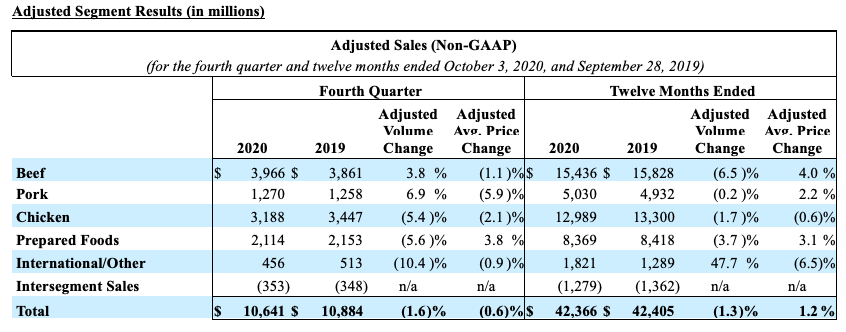
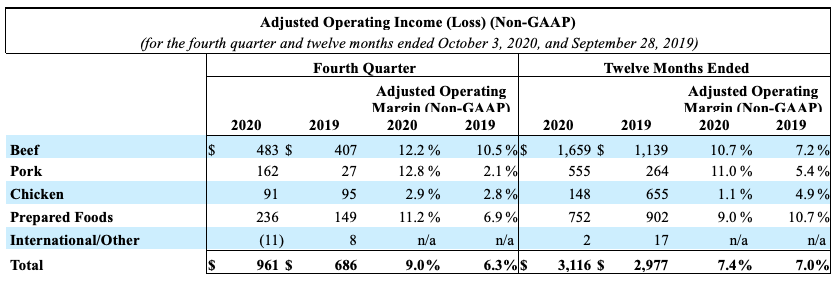
Note: Adjusted sales, adjusted operating income and adjusted operating margin are non-GAAP financial measures and are explained and reconciled to comparable GAAP measures at the end of this release. Adjusted sales, adjusted operating income, adjusted volume change, adjusted average price change and adjusted operating margin for the fourth quarter and twelve months of fiscal 2020 are presented on a 13-week and 52-week basis, respectively.
Adjusted sales (due to the impact of the additional week in the fourth quarter of fiscal 2020), adjusted operating income and adjusted operating margin are presented as supplementary measures in the evaluation of our business that are not required by, or presented in accordance with, GAAP. We use adjusted sales, adjusted operating income and adjusted operating margin as internal performance measurements and as criteria for evaluating our performance relative to that of our peers. We believe adjusted sales, adjusted operating income and adjusted operating margin are meaningful to our investors to enhance their understanding of our financial performance and are frequently used by securities analysts, investors and other interested parties to compare our performance with the performance of other companies that report adjusted sales, adjusted operating income and adjusted operating margin. Further, we believe that adjusted sales, adjusted operating income and adjusted operating margin are useful measures because they improve comparability of results of operations from period to period. Adjusted sales, adjusted operating income and adjusted operating margin should not be considered as substitutes for sales, operating income, operating margin or any other measure of operating performance reported in accordance with GAAP. Investors should rely primarily on our GAAP results and use non-GAAP financial measures only supplementally in making investment decisions. Our calculation of adjusted sales, adjusted operating income and adjusted operating margin may not be comparable to similarly titled measures reported by other companies.
COVID-19 Expenses
- We incurred direct incremental expenses associated with the impact of COVID-19 totaling approximately $200 million and $540 million for the fourth quarter and twelve months of fiscal year 2020, respectively. These direct incremental expenses primarily included team member costs associated with worker health and availability and production facility downtime, including direct costs for personal protection equipment, production facility sanitization, COVID-19 testing, donations, product downgrades and rendered product, partially offset by CARES Act credits. Other indirect costs associated with COVID-19 are not reflected in this amount, including costs associated with raw materials, distribution and transportation, plant underutilization and reconfiguration, premiums paid to cattle producers and pricing discounts.
Summary of Segment Results
- Beef - Sales volume increased 11.8%, or increased 3.8% after removing the impact of an additional week, for the fourth quarter of fiscal 2020 primarily due to a fire that caused the temporary closure of a production facility during the fourth quarter of fiscal 2019. Sales volume decreased 4.5%, or decreased 6.5% after removing the impact of an additional week, for fiscal 2020 due to lower production throughput associated with the impact of COVID-19 during portions of fiscal 2020 and a reduction in live cattle harvest capacity as a result of a fire that caused the temporary closure of a production facility for the majority of the first quarter of fiscal 2020. Average sales price decreased in the fourth quarter of fiscal 2020 associated with increased availability of live cattle supply and lower livestock cost. Average sales price increased in fiscal 2020 as beef demand remained strong amid supply disruptions related to the impact of COVID-19. Operating income increased primarily due to market conditions, including COVID-19 disruptions, which increased the spread between preexisting contractual agreements and the cost of fed cattle, and the impact of an additional week in fiscal 2020, partially offset by price reductions offered to customers, as well as production inefficiencies and direct incremental expenses related to COVID-19. Additionally, the fourth quarter of fiscal 2019 was impacted by $31 million of net incremental costs from the production facility fire.
- Pork - Sales volume increased 15.2%, or increased 6.9% after removing the impact of an additional week, for the fourth quarter of fiscal 2020 due to strong demand for our pork products and increased domestic availability of live hogs. Sales volume increased 1.8%, or decreased slightly after removing the impact of an additional week, for fiscal 2020, due to strong demand for our pork products and increased domestic availability of live hogs, offset by lower production throughput associated with COVID-19 during portions of fiscal 2020. Average sales price in the fourth quarter of fiscal 2020 decreased associated with lower livestock costs. Average sales price in fiscal 2020 increased as pork demand remained strong amid supply disruptions related to the impact of COVID-19, partially offset by lower livestock costs. Operating income increased primarily due to market conditions, including COVID-19 disruptions, which increased the spread between preexisting contractual agreements and the cost of live hogs, and the impact of an additional week in fiscal 2020, partially offset by production inefficiencies and direct incremental expenses related to COVID-19.
- Chicken - Sales volume increased 1.9%, or decreased 5.4% after removing the impact of an additional week, for fourth quarter of fiscal 2020, and increased slightly, or decreased 1.7% after removing the impact of an additional week, for fiscal 2020 primarily due to lower production throughput associated with the impact of COVID-19 during portions of fiscal 2020 and lower foodservice demand, partially offset by increased retail demand. Average sales price decreased primarily due to weaker chicken pricing as a result of market conditions. Operating income decreased primarily from market conditions, unfavorable product mix, as well as production inefficiencies and direct incremental expenses related to COVID-19. Operating income was also impacted by approximately $45 million of net derivative gains in the fourth quarter of fiscal 2020 and approximately $70 million of net losses in the fourth quarter of 2019, in addition to approximately $50 million of decreased feed ingredient costs in the fourth quarter of fiscal 2020 as compared to the fourth quarter of fiscal 2019. For fiscal 2020, net derivative results and feed ingredient costs were relatively flat as compared to fiscal 2019. Operating income was further impacted by $34 million and $21 million in restructuring costs incurred in fiscal 2020 and fiscal 2019, respectively.
- Prepared Foods - Sales volume increased 1.6%, or decreased 5.6% after removing the impact of an additional week, for fourth quarter of fiscal 2020, and decreased 1.9%, or decreased 3.7% after removing the impact of an additional week, for fiscal 2020 as growth in volume across the retail channel was offset by a reduction in the foodservice channel related to reduced demand and lower production throughput due to the impact of COVID-19 during portions of fiscal 2020. Average sales price increased in the fourth quarter and for fiscal 2020 due to favorable product mix associated with the surge in retail demand, and for fiscal 2020, the pass through of increased raw material costs. Operating income increased in the fourth quarter of fiscal 2020 due to favorable product mix associated with strong demand for retail products and the impact of an additional week, partially offset by the impacts of reduced foodservice sales. Operating income decreased in fiscal 2020 primarily due to increased operating costs, including a $105 million increase in net raw material costs and derivative losses, as well as production inefficiencies and direct incremental expenses related to COVID-19, partially offset by reduced promotional spend. Operating income was also impacted by $28 million and $18 million in restructuring costs incurred in fiscal 2020 and fiscal 2019, respectively. Additionally, operating income in the fourth quarter of fiscal 2019 was further impacted by a $41 million impairment from a planned divestiture of a business.
Outlook
For fiscal 2021, USDA indicates domestic protein production (beef, pork, chicken and turkey) should increase approximately 1% from fiscal 2020 levels. The following is a summary of the outlook for each of our segments, as well as an outlook for revenues, capital expenditures, net interest expense, liquidity, tax rate and dividends for fiscal 2021. On an adjusted basis, we anticipate the Beef and Pork segments will remain strong, although not at fiscal 2020 levels, and we believe the Chicken and Prepared Foods segments will likely strengthen in fiscal 2021 as compared to fiscal 2020.2
- COVID-19 – We continue to proactively manage the company and its operations through this global pandemic. Given the nature of our business, demand for food and protein may shift amongst sales channels and experience disruptions, but over time we expect worldwide demand to continue to increase. We are experiencing multiple challenges related to the pandemic. These challenges are anticipated to increase our operating costs and negatively impact our volumes into fiscal 2021. We cannot currently predict the ultimate impact that COVID-19 will have on our short- and long-term demand, as it will depend on, among other things, the severity and duration of the COVID-19 crisis. Our liquidity is expected to be adequate to continue to run our operations and meet our obligations as they become due.
- Beef – USDA projects domestic production will increase approximately 2% in fiscal 2021 as compared to a COVID-19 impacted fiscal 2020. For fiscal 2021, we also expect sufficient supplies in regions where we operate our plants.
- Pork – USDA projects relatively flat to slightly increased domestic production in fiscal 2021 as compared to a COVID-19 impacted fiscal 2020.
- Chicken – USDA projects a relatively flat to slightly increased outlook for chicken production in fiscal 2021 as compared to fiscal 2020.
- Prepared Foods – We will continue to be responsive to changes in consumer behavior as a result of the impacts of COVID-19 as we move into fiscal 2021.
- International/Other – We expect improved results from our foreign operations in fiscal 2021.
- Revenue – We expect sales to be $42 billion to $44 billion for fiscal 2021.
- Capital Expenditures – For fiscal 2021, we expect capital expenditures to be approximately $1.2 billion to $1.4 billion. Capital expenditures include spending for capacity expansion, growth, safety, animal well-being, infrastructure replacements and upgrades, and operational improvements that are expected to result in production and labor efficiencies, yield improvements and sales channel flexibility.
- Net Interest Expense – We expect net interest expense to approximate $440 million for fiscal 2021.
- Liquidity – We expect total liquidity, which was approximately $3.2 billion at October 3, 2020, to remain above our minimum liquidity target of $1.0 billion.
- Tax Rate – We currently expect our adjusted effective tax rate to be around 23% in fiscal 2021.
- Dividends – Effective November 13, 2020, the Board of Directors increased the quarterly dividend previously declared on August 6, 2020, to $0.445 per share on our Class A common stock and $0.4005 per share on our Class B common stock. The increased quarterly dividend is payable on December 15, 2020, to shareholders of record at the close of business on December 1, 2020. The Board also declared a quarterly dividend of $0.445 per share on our Class A common stock and $0.4005 per share on our Class B common stock, payable on March 15, 2021, to shareholders of record at the close of business on March 1, 2021. We anticipate the remaining quarterly dividends in fiscal 2021 will be $0.445 and $0.4005 per share of our Class A and Class B stock, respectively. This results in an annual dividend rate in fiscal 2021 of $1.78 for Class A shares and $1.602 for Class B shares, or a 6% increase compared to the fiscal 2020 annual dividend rate.
2 The Company is not able to reconcile its full-year fiscal 2021 adjusted results to its fiscal 2021 projected GAAP results because certain information necessary to calculate such measure on a GAAP basis is unavailable or dependent on the timing of future events outside of our control. Therefore, because of the uncertainty and variability of the nature of the amount of future adjustments, which could be significant, the Company is unable to provide a reconciliation of this measure without unreasonable effort. Adjusted measures should not be considered a substitute for operating margin or any other measures of financial performance reported in accordance with GAAP. Investors should rely primarily on the Company’s GAAP results and use non-GAAP financial measures only supplementally in making investment decisions.
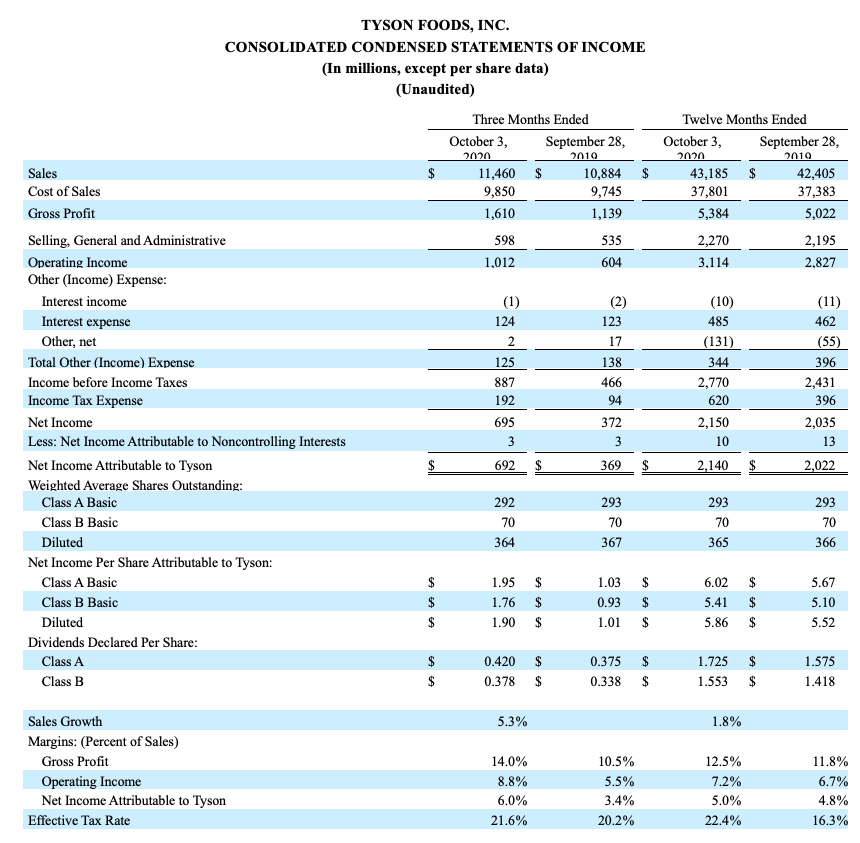
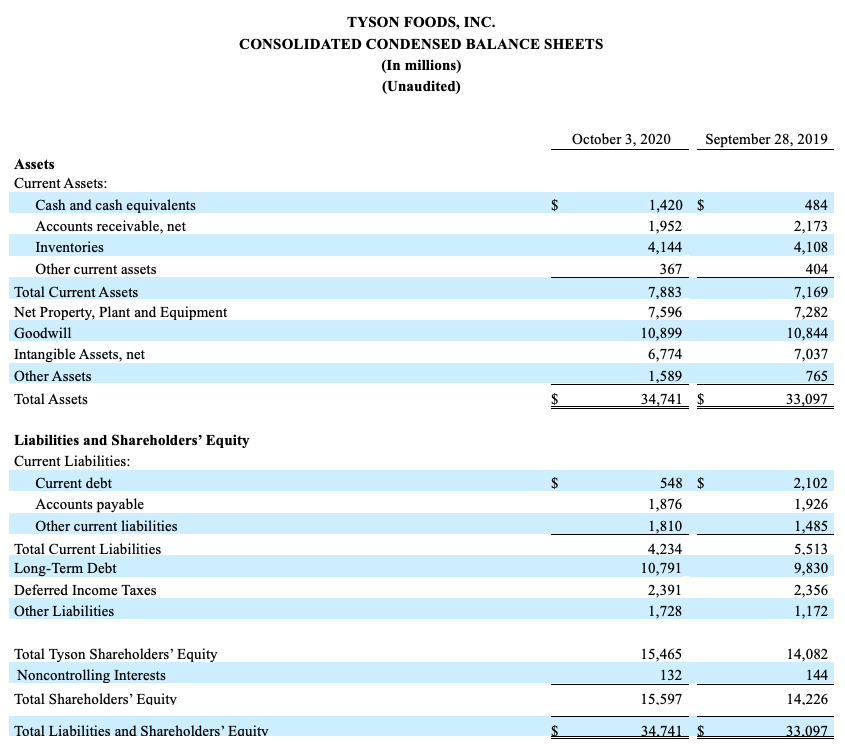
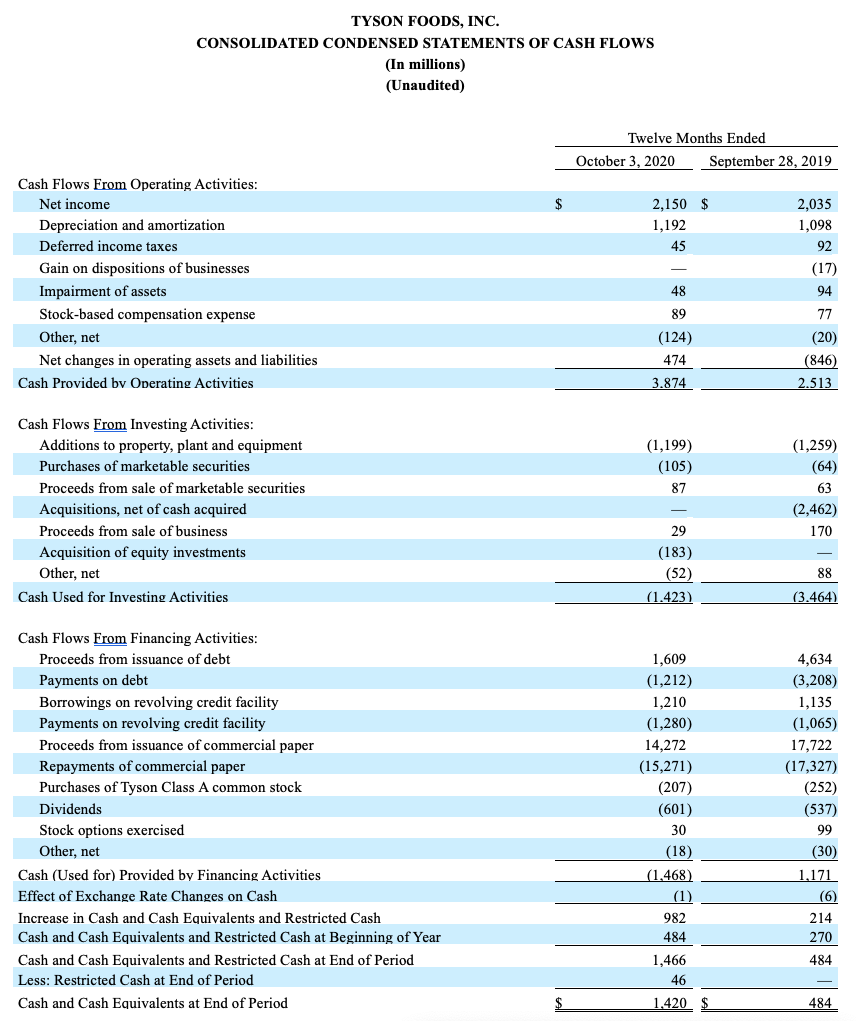
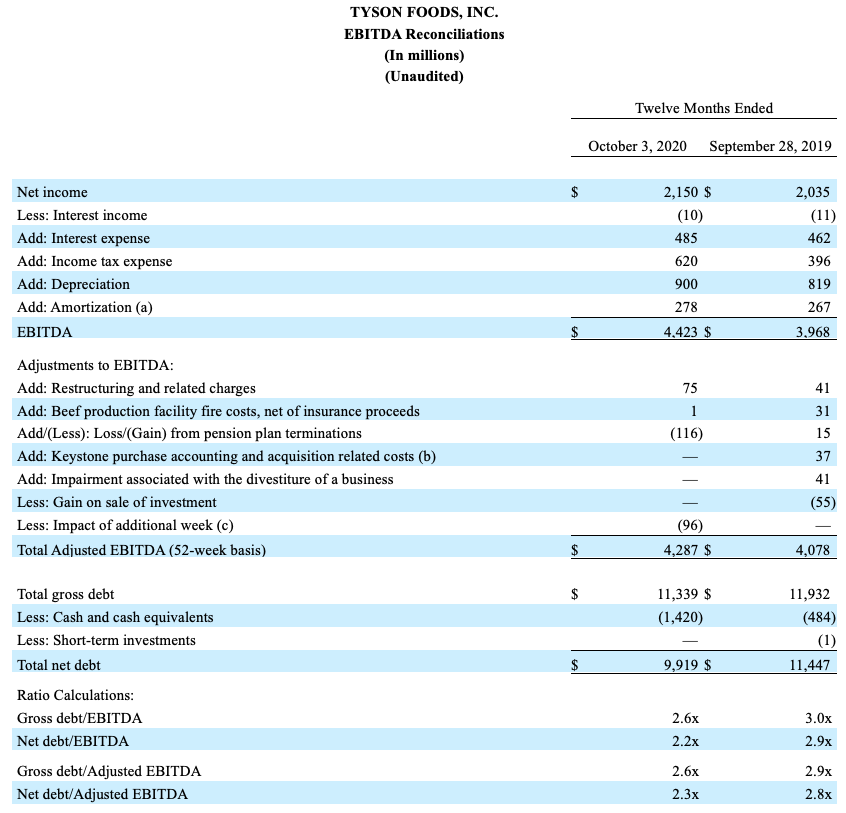
(a) Excludes the amortization of debt issuance and debt discount expense of $14 million and $12 million for the twelve months ended October 3, 2020 and September 28, 2019, respectively, as it is included in interest expense.
(b) Keystone acquisition and integration costs for fiscal year 2019 included $11 million of purchase accounting adjustments and $26 million of acquisition related costs.
(c) The estimated impact to adjusted EBITDA of the additional week in fiscal 2020 was calculated as fourth quarter EBITDA (14-week basis) of $1,322 (which is comprised of fourth quarter 14-week basis net income of $695 million, less interest income of $1 million, plus interest expense of $124 million, plus income tax expense of $192 million, plus depreciation and amortization of $312 million which excludes the amortization of debt issuance and debt discount expense of $4 million for the three months ended October 3, 2020, as it is included in interest expense) plus fourth quarter restructuring and related charges of $23 million, divided by 14 weeks.
EBITDA is defined as net income before interest, income taxes, depreciation and amortization. Net debt to EBITDA (Adjusted EBITDA) represents the ratio of our debt, net of cash, cash equivalents and short-term investments, to EBITDA (and to Adjusted EBITDA). EBITDA, Adjusted EBITDA, net debt to EBITDA and net debt to Adjusted EBITDA are presented as supplemental financial measurements in the evaluation of our business. Adjusted EBITDA is a tool intended to assist our management and investors in comparing our performance on a consistent basis for purposes of business decision-making by removing the impact of certain items that management believes do not directly reflect our core operations on an ongoing basis.
We believe the presentation of these financial measures helps management and investors to assess our operating performance from period to period, including our ability to generate earnings sufficient to service our debt, enhances understanding of our financial performance and highlights operational trends. These measures are widely used by investors and rating agencies in the valuation, comparison, rating and investment recommendations of companies; however, the measurements of EBITDA (and Adjusted EBITDA) and net debt to EBITDA (and to Adjusted EBITDA) may not be comparable to those of other companies, which may limit their usefulness as comparative measures. EBITDA (and Adjusted EBITDA) and net debt to EBITDA (and to Adjusted EBITDA) are not measures required by or calculated in accordance with generally accepted accounting principles (GAAP) and should not be considered as substitutes for net income or any other measure of financial performance reported in accordance with GAAP or as a measure of operating cash flow or liquidity. EBITDA (and Adjusted EBITDA) is a useful tool for assessing, but is not a reliable indicator of, our ability to generate cash to service our debt obligations because certain of the items added to net income to determine EBITDA (and Adjusted EBITDA) involve outlays of cash. As a result, actual cash available to service our debt obligations will be different from EBITDA (and Adjusted EBITDA). Investors should rely primarily on our GAAP results and use non-GAAP financial measures only supplementally in making investment decisions.
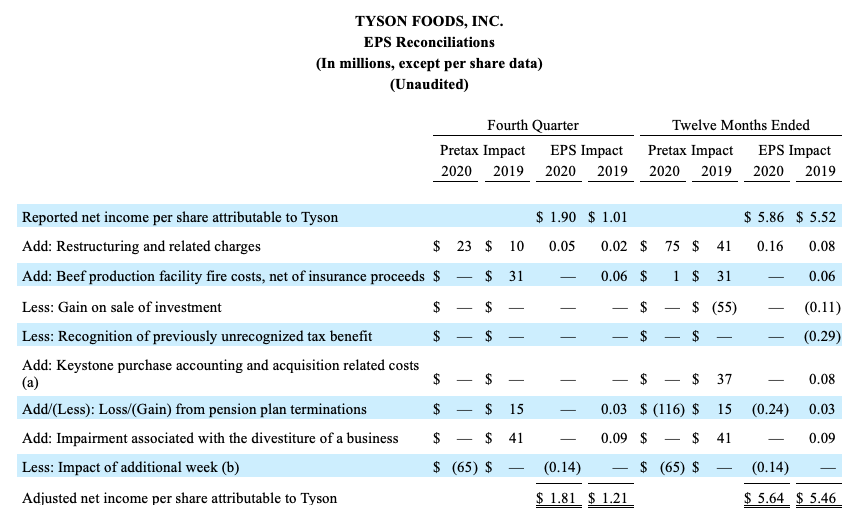
(a) Keystone purchase accounting and acquisition related costs for the twelve months of fiscal 2019 included an $11 million purchase accounting adjustment for the fair value step-up of inventory and $26 million of acquisition related costs.
(b) The estimated Pretax Impact of the additional week in the fourth quarter and twelve months of fiscal 2020 was calculated by dividing the sum of the fourth quarter's Adjusted operating income (loss) prior to adjustment for additional week (refer to Operating Income Reconciliation) net of Total Other (Income) Expense by 14 weeks.
Adjusted net income per share attributable to Tyson (Adjusted EPS) is presented as a supplementary measure of our financial performance that is not required by, or presented in accordance with, GAAP. We use Adjusted EPS as an internal performance measurement and as one criterion for evaluating our performance relative to that of our peers. We believe Adjusted EPS is meaningful to our investors to enhance their understanding of our financial performance and is frequently used by securities analysts, investors and other interested parties to compare our performance with the performance of other companies that report Adjusted EPS. Further, we believe that Adjusted EPS is a useful measure because it improves comparability of results of operations from period to period. Adjusted EPS should not be considered a substitute for net income per share attributable to Tyson or any other measure of financial performance reported in accordance with GAAP. Investors should rely primarily on our GAAP results and use non-GAAP financial measures only supplementally in making investment decisions. Our calculation of Adjusted EPS may not be comparable to similarly titled measures reported by other companies.
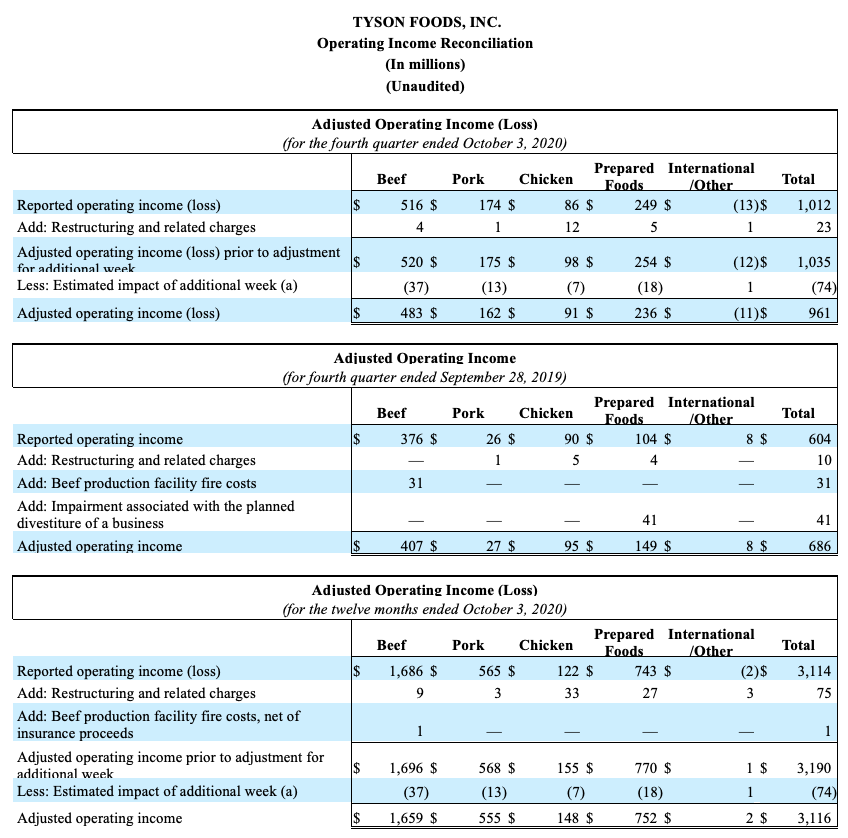
(a) The estimated impact of the additional week in the fourth quarter and twelve months of fiscal 2020 was calculated by dividing the fourth quarter's Adjusted operating income (loss) prior to adjustment for additional week by 14 weeks.

Adjusted operating income is presented as a supplementary measure of our operating performance that is not required by, or presented in accordance with, GAAP. We use adjusted operating income as an internal performance measurement and as one criterion for evaluating our performance relative to that of our peers. We believe adjusted operating income is meaningful to our investors to enhance their understanding of our operating performance and is frequently used by securities analysts, investors and other interested parties to compare our performance with the performance of other companies that report adjusted operating income. Further, we believe that adjusted operating income is a useful measure because it improves comparability of results of operations from period to period. Adjusted operating income should not be considered as a substitute for operating income or any other measure of operating performance reported in accordance with GAAP. Investors should rely primarily on our GAAP results and use non-GAAP financial measures only supplementally in making investment decisions. Our calculation of adjusted operating income may not be comparable to similarly titled measures reported by other companies.
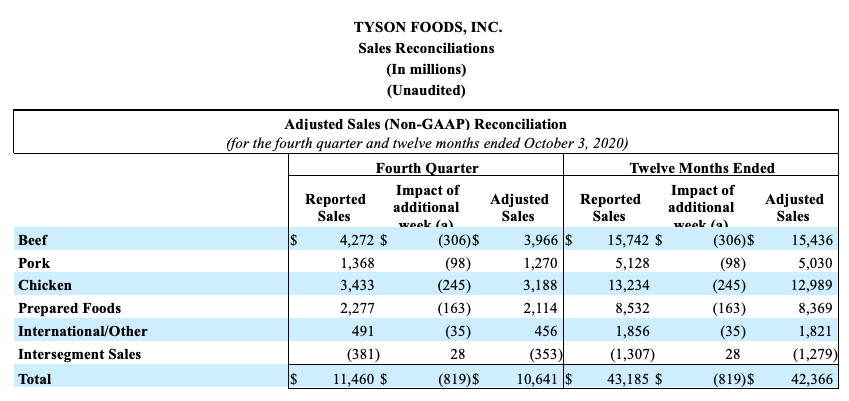
(a) The estimated impact of the additional week in the fourth quarter and twelve months of fiscal 2020 was calculated by dividing the fourth quarter's reported sales by 14 weeks.
Adjusted sales is presented as a supplementary measure of our financial performance that is not required by, or presented in accordance with, GAAP. We use adjusted sales as an internal performance measurement and as one criterion for evaluating our performance relative to that of our peers. We believe adjusted sales is meaningful to our investors to enhance their understanding of our financial performance and is frequently used by securities analysts, investors and other interested parties to compare our performance with the performance of other companies that report adjusted sales. Further, we believe that adjusted sales is a useful measure because it improves comparability of results of operations from period to period when a fiscal year results in a 53-week accounting cycle. Adjusted sales should not be considered as a substitute for sales or any other measure of financial performance reported in accordance with GAAP. Investors should rely primarily on our GAAP results and use non-GAAP financial measures only supplementally in making investment decisions. Our calculation of adjusted sales may not be comparable to similarly titled measures reported by other companies.
Tyson Foods, Inc. (NYSE: TSN) is one of the world’s largest food companies and a recognized leader in protein. Founded in 1935 by John W. Tyson and grown under three generations of family leadership, the company has a broad portfolio of products and brands like Tyson®, Jimmy Dean®, Hillshire Farm®, Ball Park®, Wright®, Aidells®, ibp® and State Fair®. Tyson Foods innovates continually to make protein more sustainable, tailor food for everywhere it’s available and raise the world’s expectations for how much good food can do. Headquartered in Springdale, Arkansas, the company had 139,000 team members at October 3, 2020. Through its Core Values, Tyson Foods strives to operate with integrity, create value for its shareholders, customers, communities and team members and serve as a steward of the animals, land and environment entrusted to it. Visit www.tysonfoods.com.
A conference call to discuss the Company's financial results will be held at 9 a.m. Eastern Monday, November 16, 2020. We encourage participants to pre-register for the conference call using the following link: https://dpregister.com/sreg/10149135/db42c360cc. Callers who pre-register will be given a conference passcode and unique PIN to gain immediate access to the call and bypass the live operator. Participants may pre-register at any time, including up to and after the call has started. Those without internet access or who are unable to pre-register may dial-in by calling toll free 1-844-890-1795 or international toll 1-412-717-9589.
To listen to the live webcast, an archived replay or to view the accompanying slides, go to the company’s investor website at http://ir.tyson.com. The webcast also can be accessed by using the direct link https://event.on24.com/wcc/r/2625854/02A14D145C84899874277F9AD1565916. A telephone replay of the call will be available until December 16, 2020, toll free at 1-877-344-7529, international toll 1-412-317-0088 or Canada toll free 855-669-9658. The replay access code is 10149135. Financial information, such as this news release, as well as other supplemental data, can be accessed from the Company's web site at http://ir.tyson.com. To download Tyson Foods’ free investor relations app, which offers access to SEC filings, news releases, transcripts, webcasts and presentations, please visit the App Store for iPhone and iPad or Google Play for Android mobile devices.
Forward-Looking Statements
Certain information in this report constitutes forward-looking statements. Such forward-looking statements include, but are not limited to, current views and estimates of our outlook for fiscal 2021, other future economic circumstances, industry conditions in domestic and international markets, our performance and financial results (e.g., debt levels, return on invested capital, value-added product growth, capital expenditures, tax rates, access to foreign markets and dividend policy). These forward-looking statements are subject to a number of factors and uncertainties that could cause our actual results and experiences to differ materially from anticipated results and expectations expressed in such forward-looking statements. We wish to caution readers not to place undue reliance on any forward-looking statements, which speak only as of the date made. We undertake no obligation to update any forward-looking statements, whether as a result of new information, future events or otherwise. Among the factors that may cause actual results and experiences to differ from anticipated results and expectations expressed in such forward-looking statements are the following: (i) the outbreak of the COVID-19 global pandemic and associated responses has had, and is expected to continue to have, an adverse impact on our business and operations; (ii) our ability to make effective acquisitions or joint ventures and successfully integrate newly acquired businesses into existing operations; (iii) the effectiveness of our financial fitness program; (iv) the implementation of an enterprise resource planning system; (v) access to foreign markets together with foreign economic conditions, including currency fluctuations, import/export restrictions and foreign politics; (vi) cyber incidents, security breaches or other disruptions of our information technology systems; (vii) risks associated with our failure to consummate favorable acquisition transactions or integrate certain acquisitions' operations; (viii) the Tyson Limited Partnership’s ability to exercise significant control over the Company; (ix) fluctuations in the cost and availability of inputs and raw materials, such as live cattle, live swine, feed grains (including corn and soybean meal) and energy; (x) market conditions for finished products, including competition from other global and domestic food processors, supply and pricing of competing products and alternative proteins and demand for alternative proteins; (xi) outbreak of a livestock disease (such as African swine fever (ASF), avian influenza (AI) or bovine spongiform encephalopathy (BSE)), which could have an adverse effect on livestock we own, the availability of livestock we purchase, consumer perception of certain protein products or our ability to access certain domestic and foreign markets; (xii) changes in consumer preference and diets and our ability to identify and react to consumer trends; (xiii) effectiveness of advertising and marketing programs; (xiv) significant marketing plan changes by large customers or loss of one or more large customers; (xv) our ability to leverage brand value propositions; (xvi) changes in availability and relative costs of labor and contract farmers and our ability to maintain good relationships with team members, labor unions, contract farmers and independent producers providing us livestock; (xvii) issues related to food safety, including costs resulting from product recalls, regulatory compliance and any related claims or litigation; (xviii) compliance with and changes to regulations and laws (both domestic and foreign), including changes in accounting standards, tax laws, environmental laws, agricultural laws and occupational, health and safety laws; (xix) adverse results from litigation; (xx) risks associated with leverage, including cost increases due to rising interest rates or changes in debt ratings or outlook; (xxi) impairment in the carrying value of our goodwill or indefinite life intangible assets; (xxii) our participation in multiemployer pension plans; (xxiii) volatility in capital markets or interest rates; (xxiv) risks associated with our commodity purchasing activities; (xxv) the effect of, or changes in, general economic conditions; (xxvi) impacts on our operations caused by factors and forces beyond our control, such as natural disasters, fire, bioterrorism, pandemics or extreme weather; (xxvii) failure to maximize or assert our intellectual property rights; (xxviii) effects related to changes in tax rates, valuation of deferred tax assets and liabilities, or tax laws and their interpretation; and (xxix) those factors listed under Item 1A. “Risk Factors” in this report and Part I, Item 1A. “Risk Factors” included in our Annual Report filed on Form 10-K for the year ended October 3, 2020.
Media Contact: Gary Mickelson, 479-290-6111
Investor Contact: Jon Kathol, 479-290-4235
Source: Tyson Foods, Inc.
Category: IR, Newsroom
